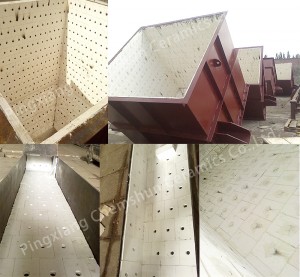1: Welding connection
Welding connection is a commonly used connection method in wear-resistant ceramic pipes. The specific steps are as follows:
1). Slot welding: First, weld slots on the inner wall of the pipe. These slots are used to fix wear-resistant ceramic sheets or linings. The welding of the slots uses hidden welding plug-in technology to ensure the stability and aesthetics of the connection.
2). Ceramic sheet installation: Then, install the arc-shaped wear-resistant ceramic sheet or lining with slots into the slots. In order to ensure the quality of the connection, an absorbent flexible binder (such as a ceramic binder, which must be able to withstand a temperature of ≥350°C) is usually used between the ceramic and the inner wall for filling, which can absorb vibration waves and play a secondary connection role.
3). Welding firmness: When welding the slots to the pipe, attention should be paid to the firmness of the welding. For example, when welding with metal parts, the number of welding points within 100mm is generally greater than 4 points, and the welding method often uses argon arc welding to fully ensure the firmness of the welding and reduce loosening and falling off caused by mechanical vibration and other reasons.
The advantage of welding connection is that the connection is firm, can withstand greater pressure and impact, and is suitable for various complex working conditions.
2. Flange connection
In addition to welding connection, wear-resistant ceramic pipes can also be connected and installed through flanges. The following issues should be noted during the installation of flange connection:
1). Handle with care: Wear-resistant ceramic pipes need to be handled with care during transportation and installation to avoid violent collisions and hard objects hitting the ceramic end face to prevent damage to the end face.
2). Precise docking: When installing ceramic pipes, the center line of the pipe should be aligned with the center line of the pipe to be connected to ensure that the two ends are accurately docked and the end face misalignment should be controlled within a certain range (such as within 1 mm).
3). Directional installation: The internal ceramic pasting method and fixing method of the wear-resistant ceramic tube determine its strict directionality. During installation, the conveyed fluid and the connection gap must be in the same direction according to the technical requirements to reduce pipeline scouring and wear.
4). Check the sealing: For wear-resistant ceramic pipes that convey fluids such as powders, gases and liquids, the sealing of the connection must be strictly checked during installation to prevent fluid leakage.
3. Other connection methods
In addition to the above two main connection methods, there are other connection methods for wear-resistant ceramic pipes, such as:
Patch connection: Use ceramic sheets or ceramic linings to directly paste them in the pipe. This connection method is more complicated to construct, requires professional construction technology, and has higher requirements for adhesives.
Hybrid connection: In some special cases, a hybrid connection method combining welding and pasting may be used to meet specific usage requirements.
In general, there are many ways to connect wear-resistant ceramic pipes, and the specific method to be selected should be determined according to the actual use and working environment. During the connection process, the relevant operating procedures and technical requirements should be strictly followed to ensure the quality and service life of the connection.
Post time: Aug-21-2024


